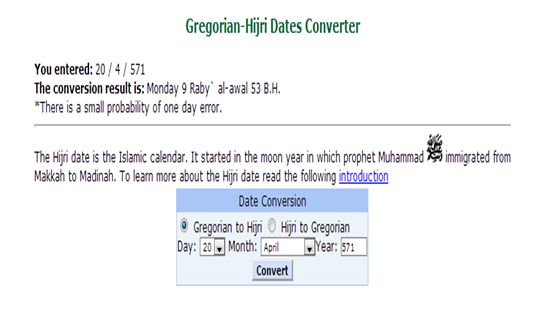By Shakil Ahmad,
It’s that time of the year once again, when a lot of Muslims gleefully and happily engage in a great celebration called “Eid Miladun Nabi” or Mawlid – 12 Raby al-Awal. What signficance does this date (12 Raby al-Awal) have under the light of Sahih Hadith? What are we really celebrating on this day?? We will try to address these few questions in this write up.
When was the Prophet Mohammad (peace be upon him) born? Let’s try to understand this according to modern technoloy and in the light of Sahih Hadith.
Abu Qatada Ansari (Allah be pleased with him) reported that Allah’s Massenger (may peace be upon him) was asked about fasting on Monday, whereupon he said: It is (the day) when I was born and revelation was sent down to me. (Sahih Muslim, Book #006, Hadith #2606)
According to this authentic Hadith, one aspect becomes very clear beyond any doubt – that Prophet Mohammad (peace be upon him) was born on a Monday.
Let’s look at another important reference, The Sealed Nectar (Al Raheeq Al Maqtoom), authored by Saifur Rahman al-Mubarakpuri . The Arabic version of this book was awarded first prize by the Muslim World League, at the first Islamic Conference on Seerah. A quotation from the book is as follows:
“Muhammad (Peace be upon him), the Master of Prophets, was born in Bani Hashim lane in Makkah on Monday morning, the ninth of Rabi‘ Al-Awwal, the same year of the Elephant Event, and forty years of the reign of Kisra (Khosru Nushirwan), i.e. the twentieth or twenty-second of April, 571 A.D., according to the scholar Muhammad Sulaimân Al-Mansourpuri, and the astrologer Mahmûd Pasha.”
This reference from The Sealed Nectar also mentions that the birth day of the Prophet (peace be upon him) is Monday. Going by the above reference, the Gregorian date is either April 20 or 22 April, 571 A.D. let’s consider and convert these two dates:
1. When we convert April 22, 571 A.D. into Hijri Calendar, the day we get is Wednesday, and the date is 11 Raby’ al-awal (53 Before Hijri). A screenshot of the conversion from the website islamicfinder.org is shown here.
2.

However, considering the Sahih Hadith of Sahih Muslim quoted previuosly, and numerous other similar Hadiths, the birth date of the Prophet (peace be upon him) is Monday. Therefore, it would only be logical to consider April 22, 571 A.D. as the birth date is not correct.
3. Now, consider April 20, 571 A.D.Converting this date to the Hijri Calendar, we get Monday, 9 Raby al-awal (53 Before Hijri). A screenshot of the conversion is as shown here:

Even if we consider the 1 day error mentioned above, the date would be either 8 Raby al-Awal or 10 Raby al-Awal. This implies that the best logical option that appears for the birth date of the Prophet (peace be upon him) is 9 Raby al-awal (53 Before Hijri) – which is Monday, April 20, 571 A.D.
4. This is in abstract contrast to what some people believe and celebrate – 12 Raby al-awal – as the Prophet’s (peace be upon him) birthday. A screenshot of the conversion is as follows:
5.

This date cannot be accepted as the birth date, since the day (Thursday) does not conform to the Sahih Hadith referred earlier.
Conclusion for Birth Date
12 Raby al-awal 53 Before Hijri cannot be accepted as the birth date of the Prophet (peace be upon him) as per the above analysis, and in the light of Sahih Hadith and the scientific date-conversion methods.
Therefore, what most of the people celebrate as EidMiladunNabi on 12 Raby al-Awal is not the birth date of the Prophet (peace be upon him). The question that still stands unanswered at large is – what are they celebrating?? Whether celebrating another Eid (or birthday) is correct or not in the light of Islam is another topic, which we have already discussed in a separate article.
